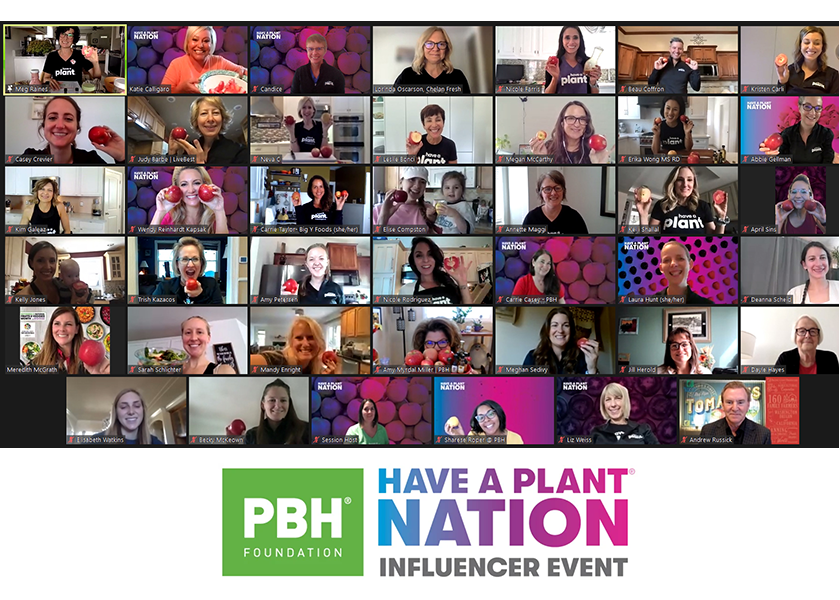PBH looks to power of habit to built fruit and vegetable consumption

Stressing the power of habits in increasing fruit and vegetable consumption, a virtual session called Insights, Ideas & Inspiration To Put More Plants On The Plate kicked off
the Sept. 28-29 Produce for Better Health Foundation’s 2021 Have A Plant Nation Ambassador Event.
“The reason why we are all doing this is because we sincerely believe that we can make a difference,” said Wendy Reinhardt Kapsak, president and CEO of the Produce for Better Health Foundation, in her opening remarks. “And we exist to help people live happier, healthier lives by eating more fruits and vegetables every single day.”
PBH believes eating more fruits and vegetables is one of the most the single most important actions people can take for their health and happiness as it relates to diet, she said.
Getting to the how
Reinhardt Kapsak said fruit and vegetable consumption is as much about the “how” consumers are eating as it is “what” they are eating.
“A large percentage of fruit and vegetable consumption, particularly among those (consumers) who eat them at the highest frequency, their consumption does appear to be habitual,” she said — habits or automatic behaviors that are internalized.
That has big implications for how the industry markets fruits and vegetables.
The industry should apply the science of habits to fruit and vegetable marketing, she said. For example, many Americans have a consistent context of brushing their teeth every day. Along with consistent context, a habit comes with repetition and reward, she said.
Making it easy for consumers to create new habits around fruits and vegetables should be a goal for the industry.
“Perhaps it is … of a lack of new fruit and vegetable consumption habits that is really stalling consumption,” Reinhardt Kapsak said.
Recent State of the Plate research indicates that consumption is falling for some produce items, and she said the decline could be partially attributed to the fact that people’s fruit and vegetable habits, or the systems that they’re operating in, are not changing, expanding, or even starting for enough people.
About two-thirds of people say they are actively trying to eat more fruits and vegetables.
The Have a Plant movement has a goal to inspire people to want to fall in love with fruits and vegetables, to make consuming fruits and vegetables a part of what they do every day — essentially an automatic habit, Reinhardt Kapsak said.
Behavior change involves equipping consumers with facts and skills, but also promoting feelings that help cultivate a long-term desire for fruits and vegetables.
That emotional connection with a positive eating experience translates into repeated behaviors over time, she said.
The pandemic fueled a desire for health and happiness, and fruits and vegetable can deliver health and happiness, she said. Research has shown that people who increase their fruit and vegetable intake see improvements in life satisfaction.
Incorporating more fruits and vegetables in breakfast, snacks, smoothies, lunch and dinner occasions can mean an uptick in life satisfaction for consumers, she said.
“This is something that we can really continue to build out in our communications,” she said.
Research also shows that consumers with the lowest levels of happiness also don’t consume many fruits and vegetables.
“Fruits and veggies really are rooted in a better mood, and there’s an opportunity for us to continue to lean in, to inspire new fruit vegetable consumption,” she said.
Beyond the health and taste attributes, making fruits and vegetables convenient to use is key to creating powerful habits.
“If you want people to do something, you need to make it easy, and to make Have a Plant a habit, it needs to be easy for consumers,” she said, whether in a retail, foodservice or an online setting.
Emotion with fruit and vegetable consumption relates to the enjoyment of the flavor of fresh produce. Marketers can tap into the enjoyment of the eating experience, especially for fruit, and also the emotional pride and/or accomplishment that come with eating fresh produce.
In the context of e-commerce, retailers have a chance to create subscriptions that put produce in digital shopping carts every week.
“Marketers have an opportunity to not just tell a story about their product, but to help consumers feel inspired to use the product and to create their own positive experiences,” she said.







